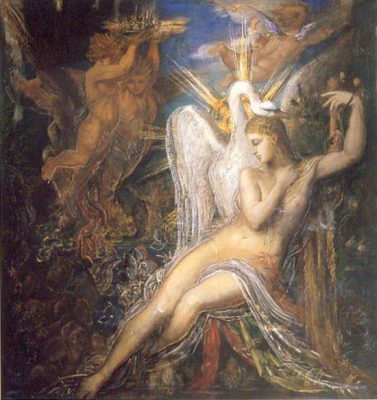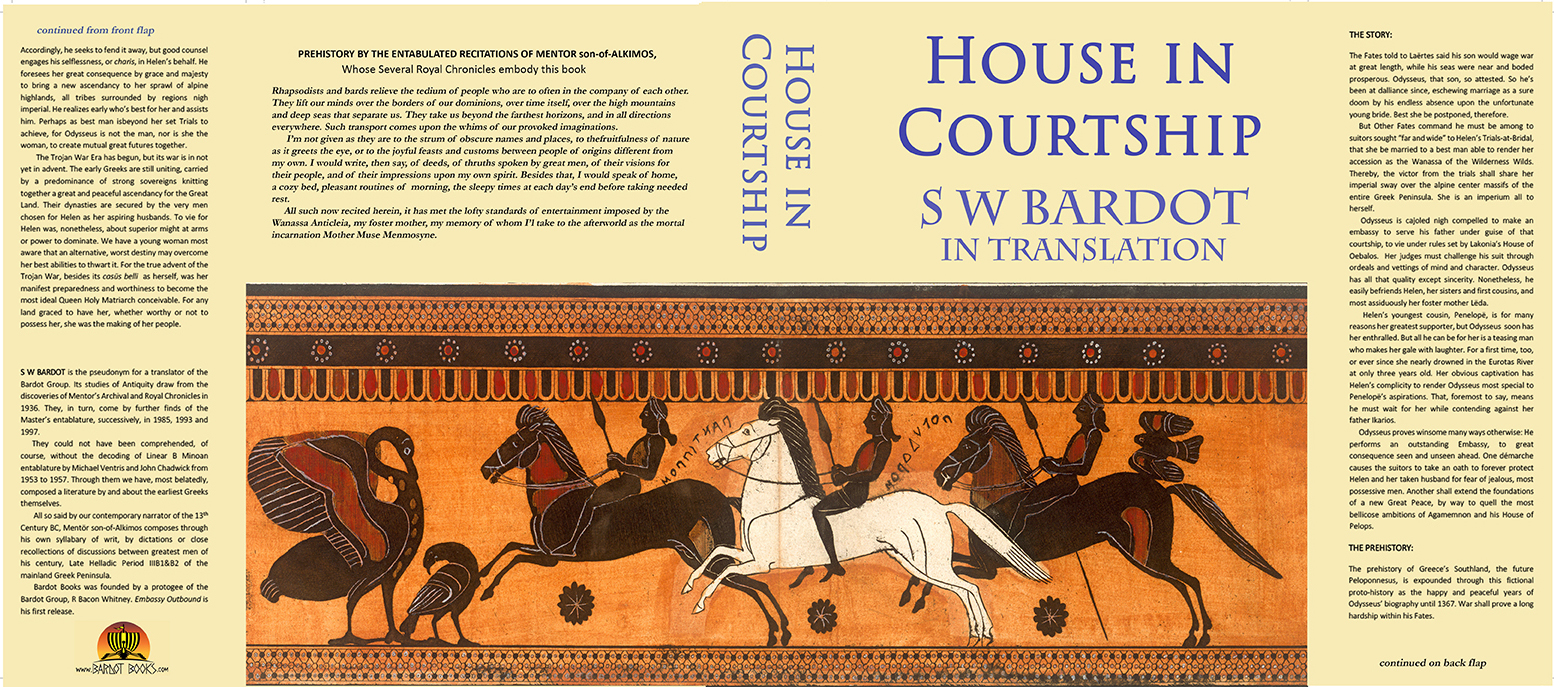[Notes:Leda was never a mortal peccadillo of Olympian Zeus, although that’s how the Ancient Greeks, so much later than the earliest Bronze Age Greeks, wished to think her. The Olympian Pantheon was nascent, although Zeus went by the name of his invocation as Dyaos, sired by Kronos Pitair off Rheia the Cretan Great Earth Mother. He was also subsumed the later names Dios, Don and Dis, by whom a composite fraternal trinity, at last — Zeus, Poseidon and Hades. There was no Olympian Pantheon, therefore.
Her Achievements Wrought from the Lower Coursing of the Eurotas River
Far downstream the upper valley of the Eurotas River lay manorial compounds and their well-irrigated plantations, as fed by many narrow gorges roughly parallel to each other and descending from the west down the Amykai Mountian Range. They dry up in summer but refill aquifers plentifully, thereby to explain why the Eurotas River sustains his flow all year round. The Amyklai Mountains were once high and snow capped to hold back spates until the summer, but such terrain could not sustain tilth or livestock pasturage. Throughout springtime chill heavy air drifted down those tumbling gorges and held the entire valley to dormancy.
The Queen Consort Lëda to the co-regent Tyndareos was an outsider from Aitolia above the Great Gulf of Korinth, living there long before she became the Wanassa of Lakonia. She never forgot the low country of Aitolia, however, through which the much great Acheloos River rendered lush marshlands of aviaries, fishing weirs and dry land oaken forests. As soon a new bride to Lakonia, and already unhappy in her marriage to an impotent husband, she had prospected her late marriage-father Oebalos’ invention of several backwater lagoons. Her marriage brother, knowing her discontent, encourged her supervision over the curbing of Eurotas’ downstream calms, causing a savanna of torpid marshlands during summers for a considerable low country. Instantly, she’d seen much grander possibilities from their backwater formations that proved so delightful from midwinter to midspring. The broad calms above the Gulf of Lakonia lay the Eurotas’ constantly replenished backwater domain, at behind a broad shelve of shoaled coastline. The reflected sunshine off Leda’s many accomplished lagoons and formed islets proved further conducive to southern exposure of Lakonia to warm the gulf climate .
Born to the Aetolian seaside of the Great Achelöos River estuary of winding sloughs, and loving the sea and lake side of his lower extent of deep channels through accreted alluvium, she replicated such environs as a pleasure resort for visiting Argives and Lakonians. Cretans and Levantine merchants had also enjoyed her endeavors by preferring dense habitation within a coastal caravansary that staged their deep interior penetration by caravans of entrained trade goods. Kindred relations developed from their commingling with denizens of Laas and Gythion where a small populace of seafaring Hyperboreans, whose wanderings had ended when a legendary king Lelex caused them to be named after him as the Leleges. The highly acculturated Cretans had also been refugees from the invasion and long occupation years of “The Mother Island” by mainlander Argives between 1450 and 1400 BC. Despite the length of the Gulf of Lakonia, Leda’s Helos Lagoon had beckoned them across to its highly favored mainland ally. Because of, or besides such alliance, their twenty years of active commerce with Ikarios, the Lelegans large caste of shipwrights off Crete so relocated, had built merchant round-hulls for Lakonia and nearby Andanaia. At reign of all thaat we introduce here for a first time, Tyndareos’ co-regent brother Ikarios, the once young man of quiet means and demeanors to affect his exceptionally able capacities of chief administration and stewardship over all agronomy and export commerce reaped from Lakonia’s small native populace over most of the Late Helladic Period (of the Greek Bronze Age). We shall come to know him well in conjunction with his daughter Penelope’s husband Odysseus, although they together had many bad years at first, by trying each others’ brilliant capacities to wed Ikarios land based governances to the foremost navarch who would lead all naval forces by the end of the Trojan War.
Helos had flourished over Lëda’s fifteen years duration of preoccupation Helos’ seaside and spstream construction projects; she exploited the riverside lower courses of the Eurotas with the genius of a born Aetolian who loved water fowl and how they ponded together to settle all low country as a most bounteous aviary. Before Odysseus and Mentör first visited and could bear source witness of that port’ s inland extents of residential compound layouts, Lëda had expended Ikarios considerable largess of material and and concerted labor corvees upon gigantic volumes of landfill upstream of Oebalos’ first sturdy sea walls built over the solidity of a shallow shoal that curbed the Eurotas deeply behind the Gulf of Lakonia. Many divides of runoff affected a unique final debouch to form the head of the Lakonian Gulf where that shoal terminated by a man made cut which balanced weak tidal flow against the final strength of the Eurotas’ late springtime flow. Tyndareos’ patron chieftains and all the richest native matrons of far upstream plantation demesnes had supplemented her efforts generously, even to preferring such coastal indulgences to their young but also very pleasant summertime residences in about of far upstream Therapne.
Commodore Medon and after him Sonios had greatly assisted the Queen by teaching the Lakonians the easiest means to dredging out eddies by reforming sloughs of lower river seepages and brief seasonal overflows. Altogether they had rendered geomorphic wonders under her royal stewardship. Great Father Eurotas’ freshets performed the rest of her needs of him through his natural proclivities. For each side of Oebalos’ upstream curbed channel proved out to lovely, uplifted strands of sandy silt below accreted finest soils by the constant erosion carried off the Amyklai Mountains eastern facing slopes.
Helos Township, Commons and Portside Amenities
Helos, the pleasance village per se, became another prehistoric hallmark of the prolonged Great Peace of Thyestes. It was still pervasive throughout the Peloponnese before Odysseus met his future bride Penelope. As the supre doyenne of Helos, indeed the foundress of the pleasure port’s entire layout, Queen Consort Lëda brought excitement to the many Persëids of the high royal family descended from Andromeda and her only daughter Gorgophone. [Lakonia. I remark, was deemed a high kingdom because derivative of their matriarchate, established in the early 16th century BC by Perseus, the valiant husband of Andromeda. The Great Princess Gorgophonë had at least two of her same name to become Wanassas of Amyklai. They were before the last wanaassa spun off from her vast region off two patriarchal Houses, of Pereires and of Oebalos, respective to Andania and Lakonia. My mapping shows them as great river valleys split by snowcapped Mount Taygetos of the Amykai Mountain Range. The last Gorgophone dead by 1280 BC, Leda became free to accomplish with Ikarios many further great public works. Least known about her, such was her married lifetime by way of cloaking the discrete disport of herself away from Tyndareos and his sole preoccupation with horse breeding upon his expansive ranches of Gangania, denoted by a yellow zone upon the afforded mapping.
Figure : Ancient Amyklai of the Southland, during the 1260s BC of the Late Helladic Period.
The original matriarchate of Gorgophonë, Amykia, before she divided its two valleys, the Pamissos and the Eurotas, to create patron royal Houses for her husbands Pereïres and Oebalos at the end of the 14th century BC. Two regions, therefore, became called Andania and Lakonia; they were divided from each other by the Amykai Mountain Range whose centerpieve highest summit was Mount Taygetos.
Besides making Helos her special spa, the once humble treaty bride become Wanassa of Lakonia after Ikarios managed a defiance of recalcitrant manorial governesses and Nasiad priestesses, the latter hereditary plantation conservators, in order to build his trespassing Long Road beginning from a new trading port at Laas. That civil war supressed by many confiscations and reversions to royal titular lands, the rural damoi of the entire Eurotas Valley were beholden to Lëda as their arch-benefactress. To her, as well, by our contemporary narrator Mentor’s long retrospective upon Lakonia’s past, was owed veneration and thanksgiving each spring and autumn as the queen mother Incarnate of the Sowing and Harvest Seasons. As shall be explained in proper time and orderly occasion, she performed to that dual honorific with great modesty and selfless discretion; but also with the most serious sense of her duties and of just how their required performance, entailing as they did her taken lovers — only a few — to sire her royal brood as Tyndareos could not.
Helos’ splendor as a resort was markedly seasonal of course. In the summer the lagoons lofted a most tortuous humidity; it also wafted a fetid, swampy shoreline of feverish miasma. That hosted swarms of pestering mosquitoes and flesh-nippers. The Lakonian Gulf becomes a blindingly bright heat sink of thick doldrums that forstall as impotent both sea and land breezes. It was abandoned then until next cooling months of late autumn, therefore, while the adjoining vast savanna pastured the drought hardy sheep for which Lakonia was also famous.
By contrast, nonetheless, the coastal gulf resort was. as said, a supremely balmy, almost semi-tropical place. Even when chilled by cold rains descending off Mount Taygetos and his sister summits, it stays far warmer than any Peloponnesian interior plantations can attain. Upstream of Helos, the original marshy shoreline above the estuary presents a series of small islands bedecked with palms planted upon ornately delineated swales. Tiny islets were connected by small bridges, themselves for crossing to tree-lined promenades which offered shady lanes. These lead away to isolated bungalows amidst elaborate residency compounds. The entirety land-locked by an extensive low dike works, the occasional open fields along the eastern verge of estuary allowed pleasant venues for holiday gatherings and market fairs hosted by transient Levantines at offering their oriental rare goods meets, all offladen from their long cruising merchant fleets.
Helos became the first venue of Helen’s Trials-at-Bridal in 1268 BC, about which we’ll have much to say through featuring the Bardot Book, House at Courtship, whose draft dust cover below.

for the Bardot Group of Scholars of Antiquity, from State College, Pewnnsylvania




You must be logged in to post a comment.